Yunpu Zhang
Rotatable Antenna Aided Mixed Near-Field and Far-Field Communications in the Upper Mid-Band: Interference Analysis and Joint Optimization
Sep 05, 2025Abstract:In this paper, we propose to leverage rotatable antennas (RAs) for improving the communication performance in mixed near-field and far-field communication systems by exploiting a new spatial degree-of-freedom (DoF) offered by antenna rotation to mitigate complex near-field interference and mixed-field interference. Specifically, we investigate a modular RA-enabled mixed-field downlink communication system, where a base station (BS) consisting of multiple RA subarrays communicates with multiple near-field users in the presence of several legacy far-field users. We formulate an optimization problem to maximize the sum-rate of the near-field users by jointly optimizing the power allocation and rotation angles of all subarrays at the BS. To gain useful insights into the effect of RAs on mixed-field communications, we first analyze a special case where all subarrays share the same rotation angle and obtain closed-form expressions for the rotation-aware normalized near-field interference and the rotation-aware normalized mixed-field interference using the Fresnel integrals. We then analytically reveal that array rotation effectively suppresses both interference types, thereby significantly enhancing mixed-field communication performance. For the general case involving subarray-wise rotation, we propose an efficient double-layer algorithm to obtain a high-quality solution, where the inner layer optimizes power allocation using the successive convex approximation (SCA) technique, while the outer layer determines the rotation angles of all subarrays via particle swarm optimization (PSO). Finally, numerical results highlight the significant performance gains achieved by RAs over conventional fixed-antenna systems and demonstrate the effectiveness of our developed joint design compared to benchmark schemes.
Physical-Layer Security in Mixed Near-Field and Far-Field Communication Systems
Apr 28, 2025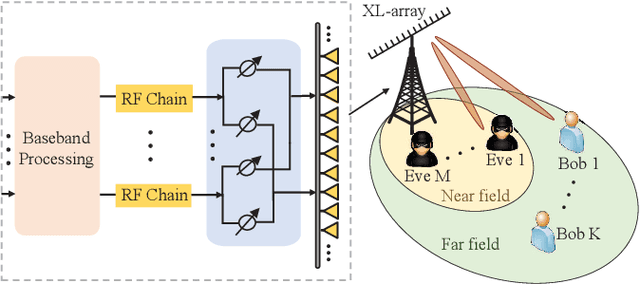
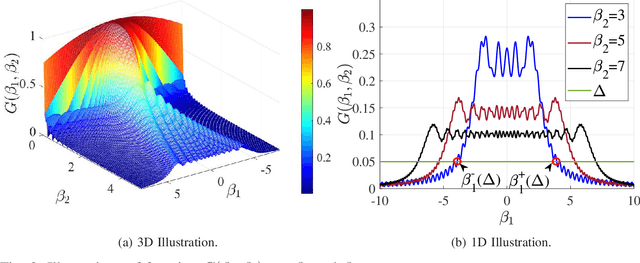

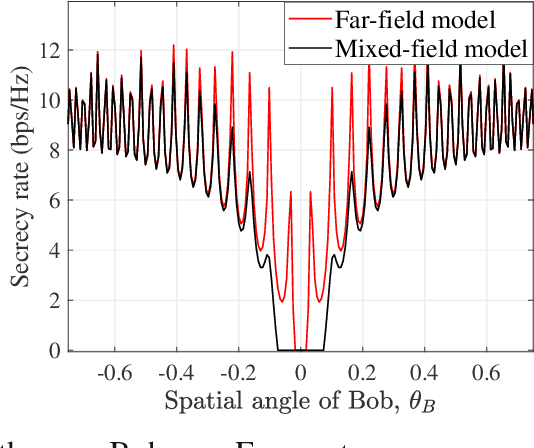
Abstract:Extremely large-scale arrays (XL-arrays) have emerged as a promising technology to improve the spectrum efficiency and spatial resolution of future wireless systems. Different from existing works that mostly considered physical layer security (PLS) in either the far-field or near-field, we consider in this paper a new and practical scenario, where legitimate users (Bobs) are located in the far-field of a base station (BS) while eavesdroppers (Eves) are located in the near-field for intercepting confidential information at short distance, referred to as the mixed near-field and far-field PLS. Specifically, we formulate an optimization problem to maximize the sum-secrecy-rate of all Bobs by optimizing the power allocation of the BS, subject to the constraint on the total BS transmit power. To shed useful insights, we first consider a one-Bob-one-Eve system and characterize the insecure-transmission region of the Bob in closed form. Interestingly, we show that the insecure-transmission region is significantly \emph{expanded} as compared to that in conventional far-field PLS systems, due to the energy-spread effect in the mixed-field scenario. Then, we further extend the analysis to a two-Bob-one-Eve system. It is revealed that as compared to the one-Bob system, the interferences from the other Bob can be effectively used to weaken the capability of Eve for intercepting signals of target Bobs, thus leading to enhanced secrecy rates. Furthermore, we propose an efficient algorithm to obtain a high-quality solution to the formulated non-convex problem by leveraging the successive convex approximation (SCA) technique. Finally, numerical results demonstrate that our proposed algorithm achieves a higher sum-secrecy-rate than the benchmark scheme where the power allocation is designed based on the (simplified) far-field channel model.
SWIPT in Mixed Near- and Far-Field Channels: Joint Beam Scheduling and Power Allocation
Oct 31, 2023Abstract:Extremely large-scale array (XL-array) has emerged as a promising technology to enhance the spectrum efficiency and spatial resolution in future wireless networks by exploiting massive number of antennas for generating pencil-like beamforming. This also leads to a fundamental paradigm shift from conventional far-field communications towards the new near-field communications. In contrast to the existing works that mostly considered simultaneous wireless information and power transfer (SWIPT) in the far field, we consider in this paper a new and practical scenario, called mixed near- and far-field SWIPT, where energy harvesting (EH) and information decoding (ID) receivers are located in the near- and far-field regions of the XL-array base station (BS), respectively. Specifically, we formulate an optimization problem to maximize the weighted sum-power harvested at all EH receivers by jointly designing the BS beam scheduling and power allocation, under the constraints on the maximum sum-rate and BS transmit power. First, for the general case with multiple EH and ID receivers, we propose an efficient algorithm to obtain a suboptimal solution by utilizing the binary variable elimination and successive convex approximation methods. To obtain useful insights, we then study the joint design for special cases. In particular, we show that when there are multiple EH receivers and one ID receiver, in most cases, the optimal design is allocating a portion of power to the ID receiver for satisfying the rate constraint, while the remaining power is allocated to one EH receiver with the highest EH capability. This is in sharp contrast to the conventional far-field SWIPT case, for which all powers should be allocated to ID receivers. Numerical results show that our proposed joint design significantly outperforms other benchmark schemes without the optimization of beam scheduling and/or power allocation.
Near-Field Beam Training: Joint Angle and Range Estimation with DFT Codebook
Sep 21, 2023Abstract:Prior works on near-field beam training have mostly assumed dedicated polar-domain codebook and on-grid range estimation, which, however, may suffer long training overhead and degraded estimation accuracy. To address these issues, we propose in this paper new and efficient beam training schemes with off-grid range estimation by using conventional discrete Fourier transform (DFT) codebook. Specifically, we first analyze the received beam pattern at the user when far-field beamforming vectors are used for beam scanning, and show an interesting result that this beam pattern contains useful user angle and range information. Then, we propose two efficient schemes to jointly estimate the user angle and range with the DFT codebook. The first scheme estimates the user angle based on a defined angular support and resolves the user range by leveraging an approximated angular support width, while the second scheme estimates the user range by minimizing a power ratio mean square error (MSE) to improve the range estimation accuracy. Finally, numerical simulations show that our proposed schemes greatly reduce the near-field beam training overhead and improve the range estimation accuracy as compared to various benchmark schemes.
Near-Field Beam Management for Extremely Large-Scale Array Communications
Jun 28, 2023Abstract:Extremely large-scale arrays (XL-arrays) have emerged as a promising technology to achieve super-high spectral efficiency and spatial resolution in future wireless systems. The large aperture of XL-arrays means that spherical rather than planar wavefronts must be considered, and a paradigm shift from far-field to near-field communications is necessary. Unlike existing works that have mainly considered far-field beam management, we study the new near-field beam management for XL-arrays. We first provide an overview of near-field communications and introduce various applications of XL-arrays in both outdoor and indoor scenarios. Then, three typical near-field beam management methods for XL-arrays are discussed: near-field beam training, beam tracking, and beam scheduling. We point out their main design issues and propose promising solutions to address them. Moreover, other important directions in near-field communications are also highlighted to motivate future research.
Joint Beam Scheduling and Power Allocation for SWIPT in Mixed Near- and Far-Field Channels
Apr 24, 2023Abstract:Extremely large-scale array (XL-array) has emerged as a promising technology to enhance the spectrum efficiency and spatial resolution in future wireless networks, leading to a fundamental paradigm shift from conventional far-field communications towards the new near-field communications. Different from the existing works that mostly considered simultaneous wireless information and power transfer (SWIPT) in the far field, we consider in this paper a new and practical scenario, called mixed near- and far-field SWIPT, in which energy harvesting (EH) and information decoding (ID) receivers are located in the near- and far-field regions of the XL-array base station (BS), respectively. Specifically, we formulate an optimization problem to maximize the weighted sum-power harvested at all EH receivers by jointly designing the BS beam scheduling and power allocation, under the constraints on the ID sum-rate and BS transmit power. To solve this nonconvex optimization problem, an efficient algorithm is proposed to obtain a suboptimal solution by leveraging the binary variable elimination and successive convex approximation methods. Numerical results demonstrate that our proposed joint design achieves substantial performance gain over other benchmark schemes.
Applications of Uncalibrated Image Based Visual Servoing in Micro- and Macroscale Robotics
Apr 17, 2023Abstract:We present a robust markerless image based visual servoing method that enables precision robot control without hand-eye and camera calibrations in 1, 3, and 5 degrees-of-freedom. The system uses two cameras for observing the workspace and a combination of classical image processing algorithms and deep learning based methods to detect features on camera images. The only restriction on the placement of the two cameras is that relevant image features must be visible in both views. The system enables precise robot-tool to workspace interactions even when the physical setup is disturbed, for example if cameras are moved or the workspace shifts during manipulation. The usefulness of the visual servoing method is demonstrated and evaluated in two applications: in the calibration of a micro-robotic system that dissects mosquitoes for the automated production of a malaria vaccine, and a macro-scale manipulation system for fastening screws using a UR10 robot. Evaluation results indicate that our image based visual servoing method achieves human-like manipulation accuracy in challenging setups even without camera calibration.
Mixed Near- and Far-Field Communications for Extremely Large-Scale Array: An Interference Perspective
Jan 18, 2023Abstract:Extremely large-scale array (XL-array) is envisioned to achieve super-high spectral efficiency in future wireless networks. Different from the existing works that mostly focus on the near-field communications, we consider in this paper a new and practical scenario, called mixed near- and far-field communications, where there exist both near- and far-field users in the network. For this scenario, we first obtain a closed-form expression for the inter-user interference at the near-field user caused by the far-field beam by using Fresnel functions, based on which the effects of the number of BS antennas, far-field user (FU) angle, near-field user (NU) angle and distance are analyzed. We show that the strong interference exists when the number of the BS antennas and the NU distance are relatively small, and/or the NU and FU angle-difference is small. Then, we further obtain the achievable rate of the NU as well as its rate loss caused by the FU interference. Last, numerical results are provided to corroborate our analytical results.
Fast Near-Field Beam Training for Extremely Large-Scale Array
Sep 29, 2022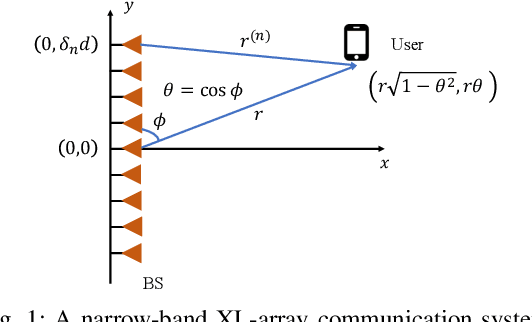
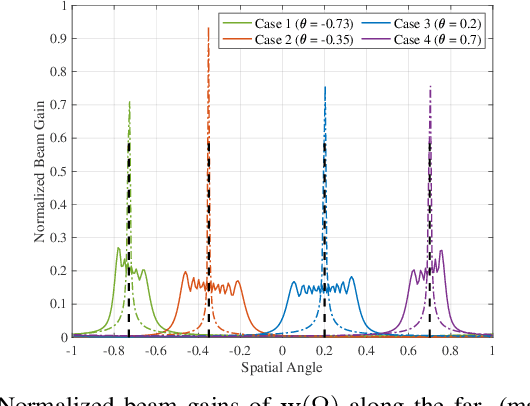
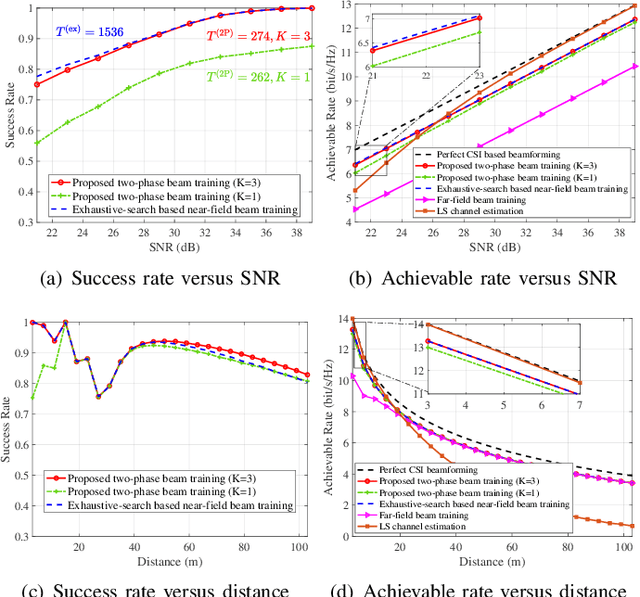
Abstract:In this letter, we study efficient near-field beam training design for the extremely large-scale array (XL-array) communication systems. Compared with the conventional far-field beam training method that searches for the best beam direction only, the near-field beam training is more challenging since it requires a beam search over both the angular and distance domains due to the spherical wavefront propagation model. To reduce the near-field beam-training overhead based on the two-dimensional exhaustive search, we propose in this letter a new two-phase beam training method that decomposes the two-dimensional search into two sequential phases. Specifically, in the first phase, the candidate angles of the user is determined by a new method based on the conventional far-field codebook and angle-domain beam sweeping. Then, a customized polar-domain codebook is employed in the second phase to find the best effective distance of the user given the shortlisted candidate angles. Numerical results show that our proposed two-phase beam training method significantly reduces the training overhead of the exhaustive search and yet achieves comparable beamforming performance for data transmission.
Multi-Active Multi-Passive -IRS Aided Wireless Communication: A Multi-Hop Beam Routing Design
Sep 14, 2022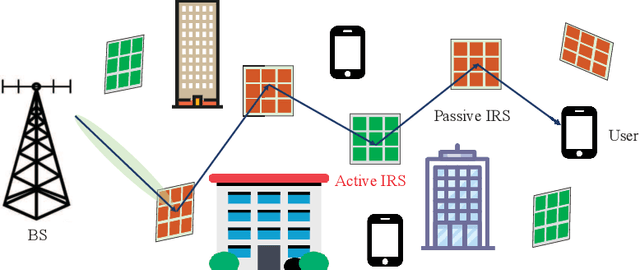

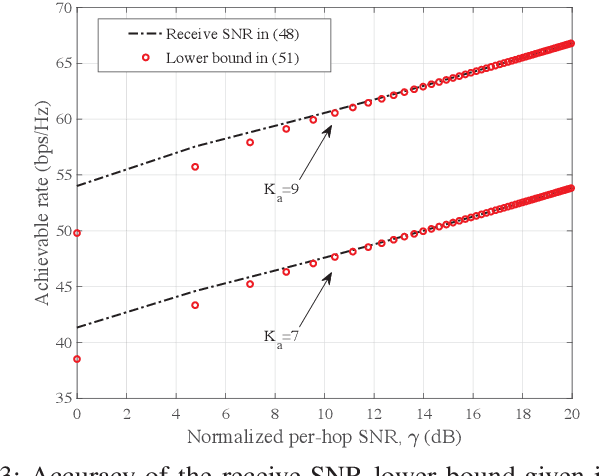
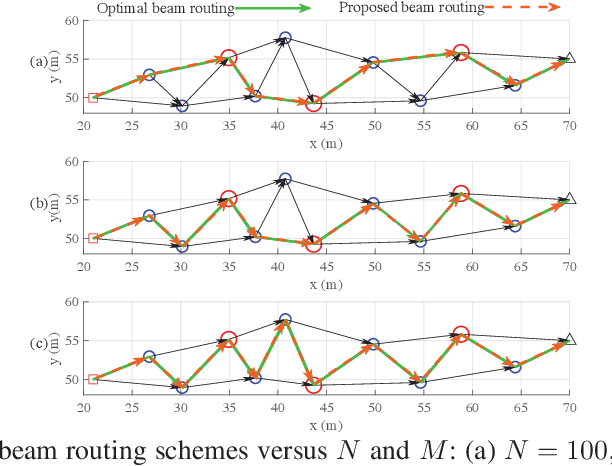
Abstract:Prior studies on intelligent reflecting surface (IRS) have mostly considered wireless communication systems aided by a single passive IRS, which, however, has limited control over wireless propagation environment and suffers severe product-distance path-loss. To address these issues, we propose in this paper a new multi-active multi-passive (MAMP)-IRS aided wireless communication system, where a number of active and passive IRSs are deployed to assist the downlink communication in complex environment, by establishing a multi-hop reflection path across active and passive IRSs. An optimization problem is formulated to maximize the achievable rate of a typical user by designing the active-and-passive IRS routing path as well as the joint beamforming of the BS and selected active/passive IRSs. To draw useful insights into the optimal design, we first consider a special case of the single-active multi-passive (SAMP)-IRS aided system. For this case, we propose an efficient algorithm to obtain its optimal solution by first optimizing the joint beamforming given any SAMP-IRS routing path, and then optimizing the routing path by using a new path decomposition method and graph theory. Next, for the general MAMP-IRS aided system, we show that its challenging beam routing optimization problem can be efficiently solved by a new two-phase approach. Its key idea is to first optimize the inner passive-IRS beam routing between each two active IRSs for effective channel power gain maximization, followed by an outer active-IRS beam routing optimization for rate maximization. Last, numerical results are provided to demonstrate the effectiveness of the proposed MAMP-IRS beam routing scheme.
 Add to Chrome
Add to Chrome Add to Firefox
Add to Firefox Add to Edge
Add to Edge